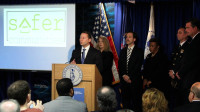County Initiative Responds to Newtown Tragedy

Remembering his personal response to the shootings at Newtown, Conn., as the situation unfolded on December 14th, Westchester County Executive Robert Astorino, told those gathered at a press conference last week that first as a father and then as an elected official he tried to answer the question: “What can we do?”
The response, after brainstorming with county commissioners and experts, is the Safer Communities Initiative, a formula that brings together existing programs that combat violence for shared education and communication so they can work together more effectively.
“This is about team effort,” Astorino said. “The issue is complicated. It involves mental health, public safety and societal factors, such as violent video games and TV shows. The answer to how we keep our kids safe has to be comprehensive because there is no one cause and no one answer.”
Acknowledging that money and time are not available, Astorino said there are resources already in place that can be tapped. “We have to break down the silos that currently exist and bring everyone to the table,” he emphasized. “We need to get everyone together to talk about best practices. With a coordinated approach, when there is a crisis we can respond because we learned from best ideas and from what has not worked in the past.”
Three county departments emerged as the leaders: Public Safety, Health and Mental Health. “We determined that these have the best expertise and will do the bulk of the work,” Astorino explained. Other departments involved are Social Services and Probation.
The next step of the formula is to reach out beyond county government to build relationships with police chiefs, school superintendents and educators in public, private and parochial schools, health practitioners, elected officials, civic leaders and clergy.
“We discovered that every group was wrestling with the same questions: What can we do? How do we prevent this? How do we react to something like this?” Astorino noted.
By creating a partnership, the Safer Communities Initiative will take all these different conversations and bring them together, educating the public about what is available.
“But people do not know what is available right now,” Astorino explained. “For example, Armonk might already have something in place, but Mamaroneck is searching. We want to get people together to talk about existing capabilities.”
Once the available services have been identified, the next step is to enhance them and then evaluate the progress on a continuing basis.
The initiative will get underway with a School Safety Symposium on Wednesday, Feb. 27 at SUNY Purchase, organized by George Longworth, Commissioner of Public Safety and the Westchester County Chiefs of Police Association. The event is designed to provide educators with practical guidance on how to make schools safer and enhance coordination between law enforcement and school districts.
“The lines of authority are already set up,” Longworth explained. “Familiarity and coordination are two critical tools when preparing for and responding to a crisis.” The concept is similar to preparing for a possible fire with fire drills.
William Bratton, former commissioner of the NYPD and former chief of police in Los Angeles will be the keynote speaker. Experts detailing best practices will include Charles Boklan, U.S. Secret Service (retired) who will give an overview of school-based violence in America; Matthew Miraglia a noted school security expert will speak about practical emergency preparedness for schools; and Chief Inspector John Hodges, Westchester County of Public Safety will talk about police response to dynamic incidents in schools.
At 11:15 a.m. there will be a panel discussion with local educators that is open to the public. Those wishing to attend will have to present identification and register at the door for entry.
On April 9, the departments of Health and Community Mental Health will hold a Community Violence Prevention Forum at the Westchester County Center. The county is working with the national Centers for Disease Control and Prevention on the program, whose emphasis will be to address violence as a public health issue.
